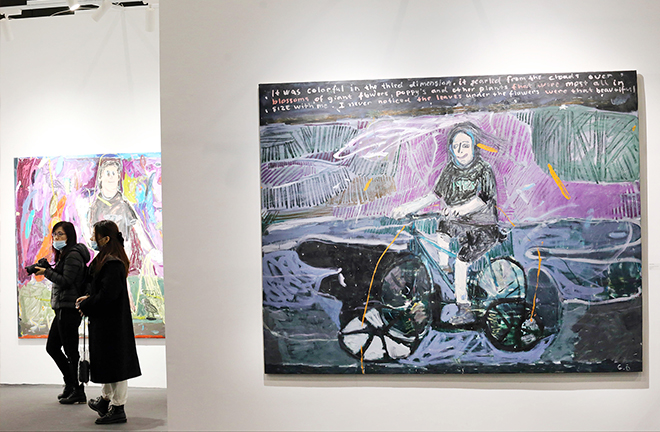New ecology of literature and art takes shape

The Nanjing Art Fair International on Nov. 26, 2020 Photo: CFP
Since the reform and opening up, China has made prominent strides in the fields of literature and art, injecting positive energy into social progress and cultural prosperity, and enhancing the people’s aesthetic realm.
New ecology
Rapid social development has further broken the boundary between art and daily life, said Xu Bihui, a research fellow from the Institute of Philosophy at the Chinese Academy of Social Sciences. In an industrial society, “artists” are a term which people reserve for a small number of talented experts with great sensitivity and special expressive abilities. However, with the gradual popularization of the internet, it has become a trend for art to penetrate into daily life. Art is no longer the privilege of a few, but part of the general public’s lives.
New historical contexts have led to new patterns and new literary and artistic practices, which can be summarized as “diversification,” said Yang Jie, a professor from the Institute of Art at the Communication University of China. Concrete manifestations of this diversification involve two forms of interactivity and three fusions. The two forms of interactivity are online and offline interactions between literary creation and criticism practices, and interactivity between traditional media and new media. The three fusions are the fusion of professional writers and amateur writers, the fusion of writers’ creations and secondary creations in readers’ reading processes, and the fusion of man and machine. These new changes will inevitably impact literary theory’s inherent paradigms, becoming a driving force for the reform of literature and art theory.
Liang Yushui, executive director of the Research Center for Contemporary Chinese Marxist Literature and Art at Jilin University, said that new forms of literature and art, such as works in digital media or works created by artificial intelligence, have spawned new business forms where artistic production and consumption interconnect. Diversification results in literary and artistic works with multiple genres and themes which coexist, together forging a new ecology for literature and art. With strengthened governance of literature and art criticism and public demands for higher-quality works, well-made literary and artistic works have flourished with profound thoughts and exquisite artistry, while theoretical circles have responded with new theoretical observations. So far, a new literature and art ecology is taking form featuring new patterns, new structures, and new order.
Practical basis
Literature and art studies feature a distinct practicality, said Fan Yugang, a professor from the Center for Literary Theory and Aesthetics at Shandong University. Rich literary and artistic practices require a conceptual openness and diverse research paradigms. Open literature and art studies are the basis for theoretical innovation.
According to Lai Daren, a professor from the School of Chinese Language and Literature at Jiangxi Normal University, the development of contemporary literature and art poses new challenges to original theoretical paradigms. It is necessary to step back from traditional theoretical modes and theoretical systems, track innovative development practices in literature and art, and examine the new reality of literary and artistic creation and aesthetic consumption.
“The richness of the real world determines diversification in literary and artistic creation, and thus determines compound traits and development trends in literature and art theory,” Yang noted. Literary and artistic practices are the logical starting point for literary and artistic theories, also the cornerstone of their emergence, existence, and development. People-centered literature and art, a concept promoted in the new era, has roots in the soil of real life and is built on the solid foundation of socialist literature and art with Chinese characteristics.
Theoretical construction
Lai suggests highlighting the subjectivity of Chinese literary theory, targeting our own social realities and literary and artistic practices, and establishing theoretical discourse with Chinese characteristics, to tackle problems facing the development of literature and art.
We ought to dialectically understand and deal with relationships between literary and artistic theories and practices, Lai added. Literature and art theories should orient themselves towards literary and artistic practices and clarify the status quo of these practices. Meanwhile, theories should strive for transcendence and foresight, to construct theoretical concepts that transcend literary and artistic realities, provide conceptual support for literature and art practices, and offer guidance in regard to artistic value and aesthetic ideals.
Professional art criticism and art evaluation is critical, Xu concluded. Professional art criticism not only undertakes the task of commenting on specific artistic works, but also guides artistic creation and social criticism trends via evaluation.
Edited by YANG LANLAN
